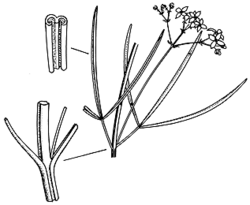Common name: Wallum Zieria
Zieria laxiflora (Benth.) Domin APNI* Synonyms: Zieria laevigata subsp. B sensu Jacobs & Pickard (1981) APNI*
Zieria laevigata subsp. laxiflora (Benth) J.A.Armstr. ined. APNI*

Description: Erect shrub to 1.2 m high, glabrous; branches ridged, not warted, glabrous.
Leaves with central leaflet ± linear, 15–55 mm long, 1.5–4.5 mm wide, apex acute to acuminate; margins revolute; upper surface not warted but dotted with oil glands, glabrous except for simple hairs along midvein furrow; lower surface not warted, velvety with short stellate hairs, midvein glabrous; petiole 5–10 mm long.
Inflorescences usually about as long as, or occasionally much longer than, leaves, commonly 9-flowered or more (range 3–51). Calyx lobes broad-triangular, c. 1.7 mm long, glabrous and often glaucous. Petals c. 3.4 mm long, imbricate, white or pale pink, tomentose.
Cocci glabrous, occasionally glaucous, slightly warted, lacking a terminal appendage.
Flowering: late winter to spring.
Distribution and occurrence: Grows in coastal heath on sands or in sandy swampy areas further inland; north from Newcastle.
NSW subdivisions: NC, CC
Other Australian states: Qld
Text by J. A. Armstrong & G.J. Harden
Taxon concept: J.A. Armstrong (2002)
APNI* Provides a link to the Australian Plant Name Index (hosted by the Australian National Botanic Gardens) for comprehensive bibliographic data
***The AVH map option provides a detailed interactive Australia wide distribution map drawn from collections held by all major Australian herbaria participating in the Australian Virtual Herbarium project.
|


